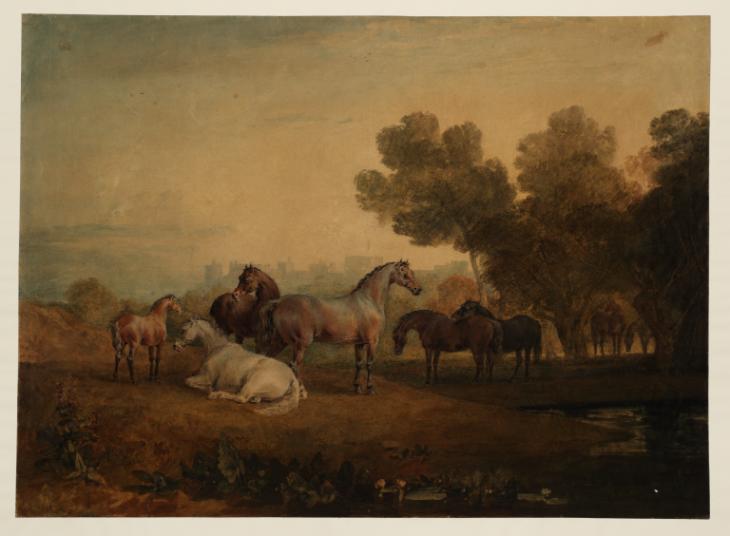Attributed to Joseph Mallord William Turner, attributed to Sawrey Gilpin Windsor Park: with Horses by the Late Sawrey Gilpin, Esq., R.A exhibited ?1811
Attributed to Joseph Mallord William Turner, attributed to Sawrey Gilpin,
Windsor Park: with Horses by the Late Sawrey Gilpin, Esq., R.A
exhibited ?1811
attributed to Joseph Mallord William Turner 1775–1851
attributed to Sawrey Gilpin 1733–1807
Windsor Park: with Horses by the Late Sawrey Gilpin, Esq., R.A. exhibited ?1811
D04158
Turner Bequest LXX G
Turner Bequest LXX G
Pencil, watercolour and scratching out, with gum arabic, on white wove paper, 577 x 771 mm
Accepted by the nation as part of the Turner Bequest 1856
Exhibition history
1811
?Royal Academy, London, 1811 (295).
1908
National Gallery, London, 1908.
1989
Turner: The Second Decade: Watercolours and Drawings from the Turner Bequest 1800–1810, Tate Gallery, London, January–March 1989 (28).
References
1870
Turner’s Celebrated Landscapes: Sixteen of the Most Important Works of J.M.W. Turner, R.A. Reproduced from the Large Engravings in Permanent Tint by the Autotype Press, London 1870, p.100 reproduced no.108.
1901
C[harles] F[rancis] Bell, A List of the Works Contributed to Public Exhibitions by J.M.W. Turner, R.A., London 1901, p.47 no.68.
A.J. Finberg, A Complete Inventory of the Drawings of the Turner Bequest, vol.I, p.175, LXX G, as ‘Group of Horses in Windsor Park’.
1910
Charles Lewis Hind, Turner’s Golden Visions, London and Edinburgh 1910 and 1925, p.265.
1961
Alexander J. Finberg, The Life of J.M.W. Turner, R.A. Second Edition, Revised, with a Supplement, by Hilda F. Finberg, revised ed., Oxford 1961, p.473 no.165.
1979
Andrew Wilton, The Life and Work of J.M.W. Turner, Fribourg 1979, pp.346–7 no.414 reproduced.
1987
John Gage, J.M.W. Turner: ‘A Wonderful Range of Mind’, New Haven and London 1987, pp.146 reproduced, 147.
1989
Robert Upstone, Turner: The Second Decade: Watercolours and Drawings from the Turner Bequest 1800–1810, exhibition catalogue, Tate Gallery, London 1989, pp.28 reproduced, 29.
2001
Martin Butlin, ‘Collaboration with Other Artists’, in Evelyn Joll, Martin Butlin and Luke Herrmann eds., The Oxford Companion to J.M.W. Turner, Oxford 2001, p.51.
Andrew Loukes, ‘Gilpin, Sawrey (1733–1807)’, in Oxford Companion, p.125.
Technique and condition
This composition of pencil, watercolour and gouache was executed on white wove paper watermarked ‘HAYES & WISE 1799’. There is preliminary sketching under the paint of this composition. The horses are outlined in pencil and their legs and spines have been shaded. They were then filled in using drops of wet paint; less care has been taken with the horses’ faces. The background was painted last and care was taken to paint right up to the edges of the horses, which lends support to the idea that the animals were not actually painted by Turner, though the rest of the image was. Pigments used include ochres and Mars orange, black, and possibly indigo.
Helen Evans
October 2008
Revised by Joyce Townsend
February 2011
How to cite
Helen Evans, 'Technique and Condition', October 2008, revised by Joyce Townsend, February 2011, in David Blayney Brown, ‘Windsor Park: with Horses by the Late Sawrey Gilpin, Esq., R.A exhibited ?1811 by attributed to Joseph Mallord William Turner, attributed to Sawrey Gilpin’, catalogue entry, April 2011, in David Blayney Brown (ed.), J.M.W. Turner: Sketchbooks, Drawings and Watercolours, Tate Research Publication, September 2014, https://wwwAs Finberg was the first to suggest, this watercolour was almost certainly the collaboration with Turner’s fellow Academician Sawrey Gilpin (1753–1807) shown at the Royal Academy in 1811, four years after Gilpin’s death. If so, the landscape is by Turner, the horses are by Gilpin and the work must have been started in 1805 or 1806. Gilpin had worked with a number of other artists including Johann Zoffany, George Barret and Philip Reinagle. Despite Turner’s reputation in later life for being more competitive than collaborative, he completed at least one other watercolour with Gilpin, Sunny Morning, the Cattle by S. Gilpin, R.A. exhibited at the Academy in 1799 (currently untraced)1 while another joint effort, Donkeys beside a Mine Shaft (Tate D04160; Turner Bequest LXX I), was left unfinished.
Gilpin had supported Turner’s first attempt to become an Associate of the Royal Academy in 1798. The exhibition in 1811 of a joint work was doubtless a delayed memorial to Gilpin and a gesture of loyalty to the Academy in the year Turner began lecturing as its Professor of Perspective. Moreover, as John Gage has argued, it signalled support for recent attempts by the President, Benjamin West, to repeal the rule banning artists who worked exclusively in watercolour from election as Academicians.2 West admired the new generation of specialist watercolourists like Thomas Heaphy and thought that the rise of the ‘exhibition watercolour’ and competition from the Society of Painters in Watercolour (founded in 1804) made the Academy’s rule obsolete. Turner did not show at the Society and had not sent any watercolours to the Academy since 1804, preferring to show them at his own gallery. By returning to the Academy in 1811 with a joint work with Gilpin and four other watercolours in a range of currently fashionable styles, he demonstrated that the Society did not have the monopoly of such works.
Verso:
Blank
David Blayney Brown
April 2011
How to cite
David Blayney Brown, ‘Windsor Park: with Horses by the Late Sawrey Gilpin, Esq., R.A exhibited ?1811 by attributed to Joseph Mallord William Turner, attributed to Sawrey Gilpin’, catalogue entry, April 2011, in David Blayney Brown (ed.), J.M.W. Turner: Sketchbooks, Drawings and Watercolours, Tate Research Publication, September 2014, https://www

